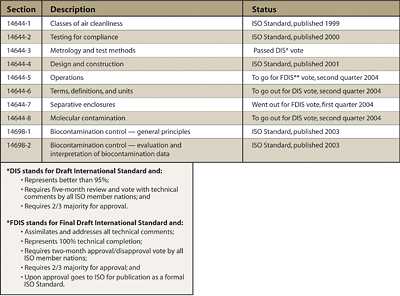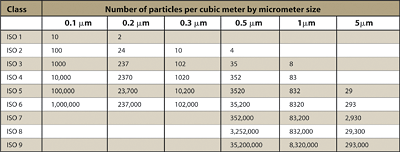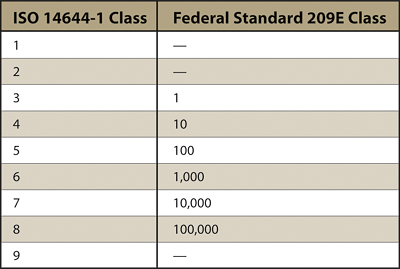
This series, known as ISO Standard 14644, is the product of ISO Technical Committee 209 (TC 209) Cleanrooms and Associated Controlled Environments, which is comprised of representatives from 19 nations. Standard 14644 consists of eight parts, some of which are finalized and some of which are still being created. TC 209 is also responsible for two ISO standards, 14698-1 and -2, which are biocontamination documents that are specific to cleanrooms.
Experts contend that the new standards will give cleanroom operators and designers a common set of references, replacing the frequently conflicting country-specific standards that were used previously. There remain questions, however, over the legal and regulatory ramifications of the standards and how each country will use the documents in the marketplace.
Reason For Change
On November 29, 2001, U.S. Federal Standard 209E (FED-STD-209E) Airborne Particulate Cleanliness Classes in Cleanrooms and Clean Zones, was officially replaced by ISO Standards 14644-1 and 14644-2. That's not to say that 209E went away entirely; it can still be used, although it is no longer being maintained and has not been updated in over a decade.For a long time in the U.S., Federal Standard 209E was the only "standard" available that gave a definition of cleanroom classification levels. The U.S. General Service Administration (GSA), in cooperation with the Institute of Environmental Sciences and Technology (IEST), wrote the standard in the early 1960s for those people involved in government contract works. It was accepted as a de facto standard by the majority of the cleanroom industry, because there were no commercial cleanroom standards available.
That all changed in 1993 with the advent of ISO's TC 209. Its mission was (and is) to develop an international standard for cleanrooms and associated controlled environments, including the standardization of equipment, facilities, and operational methods.
This change was necessary, because up until the formation of TC 209, each country had its own cleanroom standard, which differed from Federal Standard 209E. Imagine the confusion if a company building a cleanroom in the U.S. wanted to build a sister plant in another country. The result would be two plants constructed under two separate sets of requirements.
Another reason why the international standard made sense is that Federal Standard 209E had its limitations as far as classifications and particle sizes were concerned. It had been revised over the years, but it needed to be expanded so it would be a more universal standard that would allow designers and operators to classify cleanrooms well into the future.
Out of TC 209 came Standard 14644, which contains eight parts (Table 1). Different countries opted to head the various parts of the standard, with the U.S. electing to become chairperson for Parts 5 and 7.

Generic (But Detailed) Standard
Anne Marie Dixon, president of Cleanroom Management Associates, Inc., Carson City, NV, and head of the U.S. delegation and chairman of the U.S. Technical Advisory Group to ISO TC 209, said Standard 14644 is a general standard that can apply to anyone who has a cleanroom, irrespective of process or product."From the beginning, we needed to write a standard that was generic in nature. To some of the audience, that means these standards are more difficult because they are generic. To other people, they find that it gives them the flexibility they need to set up whatever classification of cleanroom and monitoring plan they need," said Dixon.
She added that the new documents cover much more ground than Federal Standard 209E. "I think engineers will find them to be the missing link in the technology that has been available thus far. Because this is really a compilation of what's available worldwide. We did not reinvent anything. We pulled together the best of all of the standards from all of the countries into one set of standards. That is going to give the designer the reference and the bibliography references that they've never had."
It is impossible to highlight all the differences between 209E and 14644, because the latter consists of much more detailed documents. In a nutshell, though, some of the information that was not contained in 209E that is now in Standard 14644 includes:
- Three more classifications for clean spaces and establishing a standard particle at .1 micron (Part 1);
- Detailed monitoring practices (Part 2);
- Comprehensive test methods (Part 3);
- Detailed design criteria and checklists (Part 4);
- Operations information that was originally covered in various military standards (Part 5);
- Current information on technology that was not even available when 209E was written (Part 7); and
- Molecular contamination information that was initially covered under NASA and military standards (Part 8).
Richard Matthews, a founder of Filtration Technology Inc., Greensboro, NC, chairman of ISO/TC 209, and president of Micron Video International, said that besides reading Parts 1 and 2, which are the keystone documents of the standard, engineers should pay particular attention to several other parts of the standard.
"Annex A of 14644-3 is important, because it spells out the 14 different kinds of tests you can use to evaluate clean space. It allows you to set up a sequence of what you need to do, and it's a great checklist. Annex H in 14644-4 is also beneficial. It's a 14-page checklist of anything that impacts the design and construction of a cleanroom," said Matthews.
All of 14644-7 is noteworthy, he believes, as there is a lot of new science covered in that document. "That's probably the most creative of the documents we've produced," noted Matthews. He also suggests looking closely at 14644-8, which discusses molecular contamination, which is becoming a very significant issue.

Legal Ramifications
It is important to note that ISO Standard 14644 is mainly a voluntary standard in the U.S. The only mandatory criteria in the ISO documents are in the Part 1 and Part 2 documents. Part 1 contains information and mathematical formulae on determining the classes of air cleanliness. Part 2 provides information on how often a cleanroom needs to be tested, depending on the type of facility in question."Everything else is a menu, a checklist - information that would be of value if you're designing, building, or operating a cleanroom," said Matthews.
That's not to say that regulatory agencies might not come along and pull various parts of the standard and make them mandatory, but as far as ISO is concerned, 14644 is mostly a voluntary standard. "The way the documents are structured, it's per agreement between buyer and seller. The only things that are not negotiable are how you determine the class of air cleanliness and how often you test. Everything else is negotiable," noted Matthews.
Michael Fitzpatrick, Phoenix, a senior member of the Institute of Environmental Sciences and Technology (IEST), designer of semiconductor facilities for over 24 years, and member of the Arizona State University ACE Cleanroom Task Force, noted that the legal and regulatory ramifications of Standard 14644 have yet to be sorted out.
"Some regulatory agencies in Asia have adopted the standards, while others have not. The standards become mandatory in the European Union (EU) six months after final publication. Firms conducting business with companies inside the EU must comply with them. Many U.S. companies have adopted a wait-and-see approach to the regulatory issues, while others have crafted plans to demonstrate compliance," he said.
If countries make the Standard 14644 series mandatory, Fitzpatrick contends this could cause serious problems, because the documents weren't written in contractual language. "If you take a document that's just a recommended practice and it is a little inconsistent or incoherent, you just blow by the flaws and life goes on. If you make it contractually binding, then those flaws become a problem."
Fitzpatrick cited several concerns within Standard 14644 documents that could cause problems in a contractual situation. For example, he said that Part 2, while a good document, could be problematic. "There's not a darn thing wrong with the meat of 14644-2. It's good material, but for a contractual document, it contradicts itself in places, and it's vague in places. But if Europe's going to tell me that it is a legal document, then I'm going to say it's a severely flawed document."
As a result, Fitzpatrick cautions cleanroom designers to look over proposals carefully and possibly run them by a lawyer if parts of Standard 14644 are included. "Other than Parts 1 and 5, I wouldn't grab one of these documents and reference it without really going through it. In the classes we teach, we recommend that designers read Part 4 and run it by their legal people before they employ it."
He recalls a situation last year in which a small start-up company wanted a cleanroom built for microelectronic machines. The clause in the contract said that the cleanroom had to be built to ISO 14644-4 specifications. Fitzpatrick asked the owner if he had really read through the document, because he should realize that based on Part 4, more money would be spent on documentation than would actually be spent on building the cleanroom.
"The owner didn't realize that, so he asked me to design the cleanroom in the ‘spirit' of 14644-4. In the U.S., I think we'll see more owners picking and choosing parts of the standard as it fits their needs, rather than using the documents as a whole," said Fitzpatrick.
Slow To Catch On
Even though parts of Standard 14644 have been around for years, some entities are still referencing Federal Standard 209E. Or, some may not even be familiar with the new ISO standard. One of the reasons for that may be that the U.S. was the last country to make obsolete its national standard. In addition, Federal Standard 209E still continues for those people who are on military or government contracts that were written prior to Federal Standard 209E being canceled.Another reason may be that Standard 14644 uses the metric system, which the U.S. has been very slow to accept. "That has been a challenge throughout our history," said Dixon. "It is very easy to have an image of a Class 100 room as being no more than 100 particles in a cubic foot of air. That image is still very powerful. It is difficult for people to understand that instead of 100 particles in a cubic foot, you have 3,520 particles in a cubic meter. That image is going to take some time."
It is important to note that the numbers of particles per cubic foot of air are not identical when translated into the metric system (Table 2). The ISO standards are slightly tighter in the particle concentration requirements. However, they are close enough that Dixon believes the industry can begin to use these dual identifications until the full transition is made.
Matthews agrees, noting that it is hard to imagine the difference between an ISO 5 and an ISO 7 classification, when everyone is used to referring to a Class 100 or Class 10,000 space (see Table 3). "It'll take a generation to move forward. I slip into the vernacular all the time, just like everybody else does. Basically it's because it's what we've grown up with and what we're comfortable with."
He encourages all those involved in the cleanroom industry to become familiar with the new standards. "If you don't read them, they'll always be a mystery, and you'll take a negative attitude toward them. But the standards will be accepted eventually. The younger engineers are becoming proficient in the metric system and familiar with the new standards. These young engineers are going to be the engineers of the future, because it's going to be second nature for them." ES
To purchase copies of the ISO Standard, go to www.iest.org.

